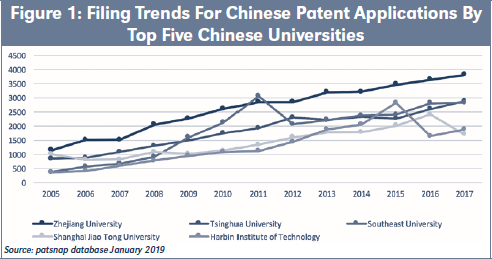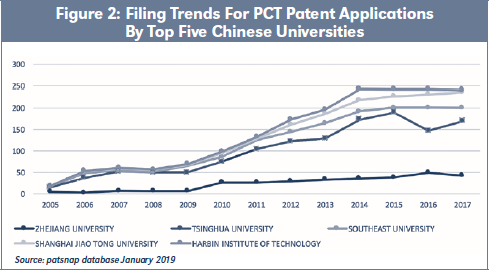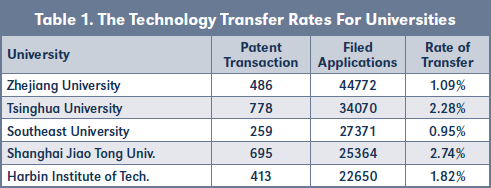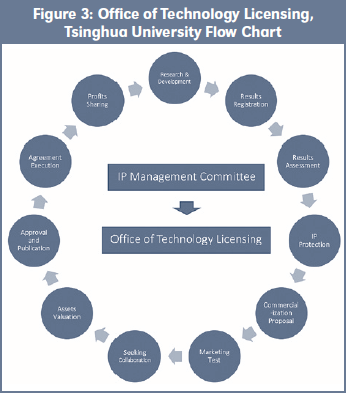les Nouvelles December 2019 Article of the Month
Commercializing Patented Technologies At Chinese Universities
Partner,
Lung Tin Intellectual
Property Agent Ltd.,
Beijing, China
Universities and other public research institutes (individually or collectively referred to as “universities”) are increasingly protecting their inventions, which would, in turn, help raise additional funding for research and spur new start-ups. The general strengthening of intellectual property protection world-wide, as well as the passage of legislation aimed at improving technology commercialization are additional factors that have facilitated the expansion of patenting in universities. In China, a dramatic increase of patent filings from universities has occurred in recent years, however, the rate for patent commercialization has been observed to be low. This short article examines the patent filings and commercialization in top Chinese universities and provides some recommendations for improvement.
In the United States, widespread university activities in technology commercialization began after the passage of the Bayh- Dole Act in 1980. This legislation enabled universities, non-profit research institutions, and small businesses to own and patent inventions developed under federally funded research programs. One purpose of the act is to provide incentives for universities to patent and commercialize their research discoveries. The Bayh- Dole Act has served as a catalyst for the development of patenting and technology transfer as new university functions, for the emergence of a new discipline of professional university technology management, and for the encouragement of greatly expanded university interests in economic development.
Now, China has grown into the world’s leading filer of domestic patent applications1 and the Chinese government strongly supports this growth through China’s National Patent Development Strategy (2011-2020), which focuses on enhancing China’s IP system and encouraging individuals, institutes, and companies to pursue IP protection domestically and abroad. Note that almost all Chinese universities or research institutes are state-owned or local-governed, and the majority of research is sponsored by government funding. Emulating the core spirit of the U.S. Bayh-Dole Act, China issued so-called “China Bayh-Dole Act” originally in 2002 by the Ministry of Finance and the Ministry of Science and Technology, which was upgraded to the national law in 2007 (the “Law of the People’s Republic of China on Scientific and Technological Progress”), to set forth the ownership of intellectual property. Except in cases where national security, national interests, or significant public interests are involved, the State grants the intellectual property developed in scientific research programs sponsored by government funding to the performing organization so that it can implement, license, or transfer the intellectual property independently. The State retains the right to use the intellectual property freely. Further, the revised Law of the People’s Republic of China on Promoting the Transformation of Scientific and Technological Achievements (effective October 1, 2015), and the supporting policies and measures subsequently introduced, improved the system for managing and commercializing scientific and technological achievements and technology investment in universities. However, implementing the legislation remains a challenge in China.
A. Growth of Patent Filings by Chinese Universities
Statistics show that as of 2015, the number of R&D (research and development) personnel in Chinese universities was 355,000, an increase of 46.7 percent over 2006, and the growth rate ranked the first in the world. Meanwhile, the internal expenditure of R&D funds in universities continued to increase, reaching 99.86 billion CNY in 2015, 3.6 times that of 2006.2
In fact, according to WIPO data,3 Chinese universities have topped U.S. universities in patenting. In 2014, top five Chinese universities, i.e., Zhejiang University, Tsinghua University, Southeast University, Shanghai Jiao Tong University, and Harbin Institute of Technology, respectively filed 2,629, 1,831, 2,109, 1,631, and 2,230 patent families; while top five universities in the U.S., i.e., University of California, Massachusetts Institute Technology, the Johns Hopkins University, Stanford University, and the University of Texas System, filed 666, 327, 275, 198, and 251 patent families, respectively. Id.
Figure 1 shows the growth of Chinese patent filings by these five top Chinese universities.

Despite the rapid growth in filing patent applications in China, the growth for filing overseas patents is relatively slow. PCT (Patent Cooperation Treaty) patent filings by these five Chinese universities are shown in Figure 2.

B. Poor Performance of Commercializing Patented Technologies at Chinese Universities
In view of the patent filings, the performance of Chinese universities in commercializing patented technologies is rather disappointing. Research results on technology transferring performance of Chinese universities4 demonstrate a correlation with the traditional perspectives on Chinese university licensing activities that a large portion (94 percent) of patents from universities had not been transferred into economic productivity. A recent publication5 also confirmed that less than five percent of patents from Chinese universities have been commercialized. Specifically, a research paper indicated that the rates at universities in the aspect of patent licensing, transfer, and commercialization are the lowest among all entities (including enterprises and individuals) with the rates of 3.30 percent, 1.90 percent, and 2.20 percent, respectively, for invention patents.6
As of January 9, 2019, recent data revealed that the poor performance of patent commercialization continues.7 The statistical results identify the technology transfer rates for universities ranging from 0.66 percent to 7.82 percent based on filed patents of inventions, utility models, and designs, and the transaction volumes and transfer rates of the afore-mentioned five top universities are reproduced in Table 1.

In addition to the low rates of technology transfer at Chinese universities, the patent licensing of Chinese universities is highly skewed with only a few universities act as main participants. As shown, about 14 percent of Chinese universities had transferred knowledge to industry through licensing patents by 2012. Data revealed that patent stocks, local economic performance, central government support, existence of technology transfer offices (TTOs), and local government administration have played certain roles in commercialization performance of universities.
C. Case Study: Mechanisms for Technology Commercialization in Tsinghua University
Despite the poor performance described above, Tsinghua University, a leading university in the country with a high level of innovation and competitiveness, has multiple mechanisms in promoting the commercialization of patented technologies.
Office of Technology Licensing, Tsinghua University
Tsinghua University has an IP Management Committee that oversees the Office of Technology Licensing, which consists of divisions of Technology Reward, Patent Management, Technology Transfer, and General Legal Affairs. See http:// www.otl.tsinghua.edu.cn/column/ wm. For details below, the office is in charge of the University’s IP policies and management. Specifically, Tsinghua University creates “Policies on Evaluation, Disposal, and Profits Distribution Relating to Scientific and Technological Achievements,” which details the policies on technology commercialization. For example, the policies specify that the revenues or profits from technology commercialization shall be distributed among the University, the department to which investigators belong, and investigators who made important contributions on the percentages of 15 percent, 15 percent and 70 percent, respectively. Id.
The flow chart below in Figure 3, is reproduced from the standard procedural process adopted by Tsinghua University to ensure that the office is involved in the process from the beginning of research and development—including evaluating research and development results, protecting relevant IP rights, and implementing commercialization—until investigators finally sign up with the partners or spin out a new company. The revenues or profits generated from the technology commercialization shall be returned to the University and the investigators in accordance with national laws and policies of Tsinghua University.10

The University-Industry Cooperation Committee (UICC)
Tsinghua University established the UICC in 1995 in an effort to promote the commercialization of technologies, to participate actively in national and regional developments, and to contribute to the society. See http://mnc.rd.tsinghua.edu.cn/new/index2.jsp?boardid=101201&sfnmfw=1. Currently, about 200 enterprises have joined the UICC, establishing a collaboration network based on a win-win partnership with Tsinghua University. These include 160 leading domestic Chinese enterprises and 40 well-known multi-national enterprises.
International Technology Transfer Center (ITTC), Tsinghua University
Tsinghua University established ITTC in 2001 in order to help Chinese enterprises seek technologies in foreign countries, to provide services for foreign technologies or products to be marketed in China, to provide consulting services for SMEs, to invest in technologies and products, and to research on technology commercialization. See http://www.ittc.com.cn/ittc/about.asp. ITTC is a national technology transfer center (i.e., at the state-level) recognized by China State Economic and Trade Commission and the Ministry of Education. Id.
Tsinghua Holdings Co., Ltd. (Tsinghua Holdings)
In September 2003, to incorporate enterprises under its control, Tsinghua University founded Tsinghua Holdings with a registered capital of 2.5 billion CNY ($395.13 million). In 2018, the company ranked 137 in China’s Top 500 enterprises by revenue and third by R&D efforts. As a Tsinghua University platform to serve society, Tsinghua Holdings has been working on bringing Tsinghua University’s scientific and technological achievements to the market, and is also the operator of the biggest university science park (i.e., TusPark) in the world. See http://en.thholding. com.cn/2016-07/23/c_53617.htm.
D. Improving Patent Commercialization at Chinese Universities
The growth of patent filings at Chinese universities is rapid, mostly due to the universities’ awareness and recognition of the values of IP. Despite the growth, the commercialization rate of patents is disappointingly low. Some commentaries believe the low rate partially reflects the low quality of patents from universities, as for some universities and their faculty, patent applications have become a substitute for scientific publications (patent applications are considerably easier to obtain than peer-reviewed journal articles).11 IP management, in most Chinese universities, essentially means filing patent applications. More, many universities regard the quantity of patents as evaluation indicators for appraisal of faculty’s performance, completion of research projects, or granting of scholarships,12 resulting in universities’ pursuing the number of patents without market demand consideration. Formalistic assessment, long review cycle, and the lack of evaluation standards are also the obstacles for investing and commercializing technologies owned by universities.13 Other factors attributing to the low rate may include: lack of institutional IP management capacity,14 lack of professional technology transferring centers,15 insufficient operating funds for technology intermediaries,16 and lack of talent in IP management and operation.17
Firstly, to improve patent commercialization at Chinese universities, while the legislation at the state level is strategic, tactic regulations at the provincial level and operational policies at the university-level are the key for implementing the legislation. Currently, regulations at the provincial level and policies at the university level shall focus on improving the quality of patents, developing a specific university-level policy based on the characteristics of each university, implementing the commercialization performance into university rankings and faculty’s performance appraisal standards, and further providing incentives for patent commercialization at universities.
In addition, the establishment of technology transfer offices (TTOs) is a necessity to bridge the gap between academic invention and commercialization. Research data clearly showed that universities with TTOs became more efficient in innovation commercialization with better performance in patent licensing.18 In reality, TTOs in Chinese universities, though in their infancy, carry out a wide range of functions, from licensing patents to companies to managing research contracts, with only a handful full-time staff. For the lack of talent in IP management and operation, using third-party intellectual property service agencies would become a solution for alleviating the difficulties. The access to experienced patent attorneys for drafting high-quality patent applications and to experienced professionals for commercializing patented technologies would overcome the main barrier to the development of TTOs.
Further, the State, using its resources, should help universities build IP management capacity, and national technology transfer centers should play a more important role in promoting and commercializing technologies. ■
Available at Social Science Research Network (SSRN):
https://ssrn.com/abstract=3380524
- In 2018, the Chinese Patent Office received 1.542 million invention patent applications and granted 0.432 million invention patents. Among the 2018 granted invention patents, 93.3% of them are service inventions, and the top three patentees are Huawei Technology Co. Ltd. (with 3,369 newly granted patents), China Petroleum and Chemical Co. Ltd. (2,849), and Guangdong OPPO Mobile Communication Co., Ltd. (2,345). See the news released on January 10, 2019 by the Chinese National Intellectual Property Administration. https://mp.weixin.qq.com/s/ n4WfnIkuNLkN-iSR7dn7Bw.
- Wei “Who Will Wake Up The Sleeping Technological Achievements In Chinese Universities?” Qizhidao Intellectual Property, 2018-04-28. See https://zhuanlan.zhihu. com/p/36234706.
- World Intellectual Property Indicators 2017 (published by WIPO), 29-97, 62.
- Gao et al. “Technology Transferring Performance of Chinese Universities: Insights from Patent Licensing Data” (2014) Advances in Applied Sociology, 289-300.
- Zhang “The Commercialization Of Patent Technologies In Universities Is Less Than 5%. How To Avoid The Waste Of Resources?” Huahuize Intellectual Property, 2018-11- 21. See https://mp.weixin.qq.com/s/k4HdSq4bYm1sBObHGHGXJw .
- Gong & Peng “Effects of Patent Policy on Innovation Outputs and Commercialization: Evidence from Universities in China” (2018) Scientometrics, 117: 687-703.
- OriginalLimit “Rankings for Transfer of University Patents.” Patents Q&A, 2019-01-07. See https://mp.weixin.qq.com/s/dN1T3Lymk-eAnUFy_w0T_w.
- Gao et al. (2014) see note 4, at 291.
- Gao et al. (2014) see note 4, at 289.
- See http://www.otl.tsinghua.edu.cn/ info/jszr_jszr/1184.
- Guo “IP Management at Chinese Universities” (2007) In Intellectual Property Management in Health and Agricultural Innovation: A Handbook of Best Practices (eds. A Krattiger, RT Mahoney, L Nelsen, et al.). MIHR: Oxford, U.K., and PIPRA: Davis, U.S.A.
- See note 5, supra.
- Ling & Ding “Investment with Intangible Assets of Chinese Research Institutions” (2018) American Journal of Applied Scientific Research, 4(2): 28-32.
- Guo (2007) note 11, supra.
- Zhang & Lou “A Quantitative Study on the Transformation of Scientific and Technological Achievements Policy in China’s Central Subordinated Universities: A Perspective from the Bayh-Dole Act” (2017) 2017 Proceedings of PICMET ’17: Technology Management for Interconnected World.
- Zhang & Lou see note 15, supra.
- See note 5, supra.
- Gao et al. (2014) see note 4.